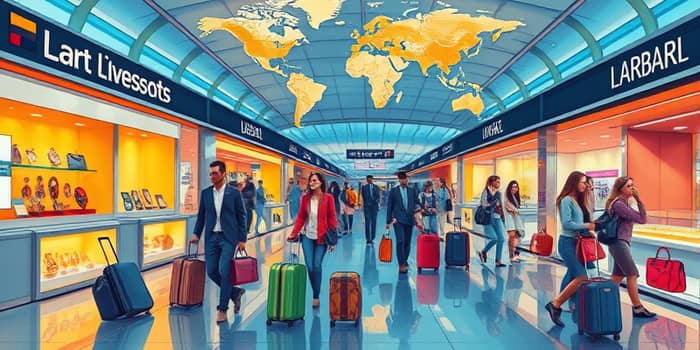
The rebound in international travel has sparked a dramatic resurgence in luxury retail worldwide. As borders reopened and flight frequencies increased, affluent consumers returned to airports and flagship stores, fueling global recovery in luxury travel. From exclusive duty-free boutiques to immersive brand experiences at major hubs, the luxury goods sector is witnessing unprecedented momentum. This article delves into the market forces, regional dynamics, consumer trends, and strategic moves underpinning this remarkable growth.
After the profound downturn of the pandemic, the luxury travel retail market is projected to grow by 7–10% annual increase for 2024–2025, outpacing global GDP forecasts. Total luxury, encompassing both goods and experiences, hit an estimated €1.48 trillion in 2024. While personal luxury goods saw a slight contraction, experience-based luxury spending surged by 5%. Global travel retail alone was valued at $83.6 billion in 2025, with projections reaching $234.1 billion by 2034 at a 12.1% CAGR.
The broader luxury travel market expanded from $1,529 billion in 2024 to an expected $1,679 billion in 2025, on track to surpass $2,762 billion by 2032. Drivers include growing flight connections, enhanced airport amenities, and renewed traveler confidence. Duty-free channels have regained their appeal through exclusive SKUs and competitive pricing, embodying experience-based luxury spending has surged in every major region.
Geographic performance shows diverse growth patterns as markets recover unevenly. Asia-Pacific leads the way, while Europe and the Middle East benefit from strong tourism traffic. Emerging regions are rapidly cultivating new luxury consumers.
The regional data reflects dominating more than forty percent share held by APAC, while India and the Middle East emerge as high-growth frontiers. European hubs continue to thrive on high-spend tourism, and the Americas find renewed opportunity as outbound travel intensifies.
Several factors underpin this vibrant expansion:
These drivers combine to support a landscape where luxury brands can connect with consumers at every touchpoint, from pre-departure online browsing to in-terminal personalized boutiques.
Luxury houses and airports are collaborating to create high-impact retail environments. Brands are immersive in-store experiences and personalization, offering bespoke services and exclusive airport-only collections. Meanwhile, major airports are reinventing terminals as lifestyle destinations, complete with art installations, wellness lounges, and curated dining concepts.
By blurring the line between transit and destination, both brands and airports ensure travelers engage with high-end offerings in memorable, convenience-driven formats.
Despite robust growth, the industry faces several hurdles. Currency fluctuations, regional volatility, and policy shifts can dampen spending patterns. The U.S. domestic market shows caution, while the withdrawal of tax-free shopping in the U.K. weighed on European sales in late 2023.
Brands must navigate these complexities with agility, employing dynamic pricing, tailored promotions, and stronger digital engagement to mitigate headwinds.
Looking ahead, global luxury spending is expected to grow at a low to mid-single-digit pace through 2027, steadily outpacing pre-pandemic performance. Asia-Pacific will remain the dominant region, while India, the Middle East, and emerging markets continue to outpace mature economies. Luxury travel retail and duty-free sales are projected to more than double by 2034, driven by ongoing technological innovation and experiential enhancements.
In this era of revival, the luxury sector stands at a crossroads of opportunity and challenge. Brands that embrace personalization, sustainability, and seamless omnichannel experiences will capture the loyal patronage of affluent travelers. Meanwhile, airports that evolve into vibrant lifestyle hubs will redefine what travel retail means in a post-pandemic world. Ultimately, the soaring sales of luxury goods are not just a testament to economic resilience—they are a celebration of human connection, aspiration, and the boundless allure of discovery.
References













